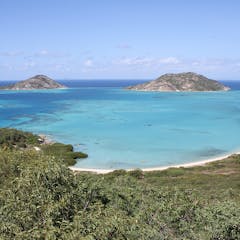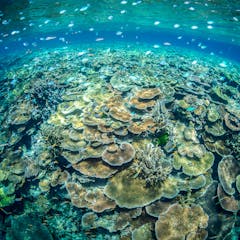
Articles on Great Barrier Reef
Displaying 1 - 20 of 282 articles

Bleached coral draws our attention, but marine heat does damage to many unseen parts of these ecosystems.

Pottery made more than 1800 years ago by Aboriginal communities on Jiigurru in the Lizard Island group in the Great Barrier Reef is the oldest ever found in Australia.

Even with the best intentions, policies from different government departments can clash.

The Great Barrier Reef is facing its worst summer of sustained heat stress since the mass bleaching event of 1998, but now with less time to recover amid repeated brutal conditions.

Our new maps show coral reefs are more extensive than we thought.

Reef sculptures are a form of artifical reef: man-made structures placed into an aquatic environment to mimic certain characteristics of a natural reef.

Experimenting with climate messaging reveals the best ways to inspire individual action. Here’s how to talk about the Great Barrier Reef this summer.

Nature’s ultimate coral predator could benefit from climate change by surviving heatwaves and lie in wait for the right moment to feast on the reef.

Australian is experimenting with marine cloud brightening to cool and shade the Great Barrier Reef. Here’s how it works.

While the Great Barrier Reed needs nutrients to support the ecosystem, it is possible to have too much of a good thing.

We used to focus just on protection of vital ecosystems like the reef. But as climate change and other threats accelerate, we need to actively help nature get ready for the heat.

In recent years, the Barrier Reef has had a reprieve – and coral has regrown strongly. But now the reprieve looks to be over and the heat is back on

The scale of climate threat is beyond the tools we have to manage the Great Barrier Reef. New measures and sustained effort are needed.

Promoting small actions, such as reducing plastic use, can be a useful entry point for other actions around climate change. It’s an example of ‘positive spillover behaviour’.

The first comprehensive audit of marine life around Australia, deploying an army of volunteer research divers alongside scientists, has revealed southern reefs are suffering the most.

The mine was not refused on climate change grounds. So without legal reform, other fossil fuel projects may still go ahead.

With the disastrous effects of climate change already upon us, past events may have lessons for the future.

UNESCO report highlights what needs to be done to save the global icon. But you might be surprised by its top recommendation.

Environment ministers from both sides are determined not to see the Barrier Reef listed as in danger. The question is – why?

Black corals provide critical habitat for many creatures that live in the dark, often barren, deep sea, and researchers are learning more about these rare corals with every dive.
